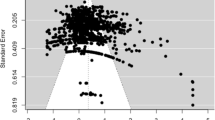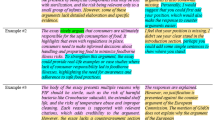Abstract
We focus on teachers’ ways of leading whole class discussions (WCDs) in mathematics, with the goal of uncovering their traces (if any) in their students’ responses (a) while participating in the WCDs and (b) in the written responses in a final test. For this purpose, two 8th-grade probability classes learning a 10-lesson unit with different teachers were observed. Our data sources include (1) video-recordings of the WCDs and (2) the responses of students to final test items. We analyzed the teachers’ talk-moves, students’ accountable participation, and students’ reasoning in the final test items. Interweaving the findings from all analyses we found differences between the classes in students’ ways of participation in WCDs and in their corresponding final test responses. The teachers’ ways of leading the WCDs contribute to the explanation of these differences.





Similar content being viewed by others
References
Asterhan, C. S. C., & Schwarz, B. B. (2009). Argumentation and explanation in conceptual change: Indications from protocol analyses of peer-to-peer dialogue. Cognitive Science, 33, 374–400.
Azmon, S. (2010). The uniqueness of teachers’ discourse—Patterns from an argumentative perspective (Unpublished doctorial dissertation). The Hebrew University, Jerusalem. [In Hebrew].
Bauersfeld, H. (1988). Interaction, construction, and knowledge: Alternative perspectives for mathematics education. In T. Cooney & D. Grouws (Eds.), Effective mathematics teaching (pp. 27–46). Reston, VA: National Council of Teachers of Mathematics and Hillsdale’ NJ: Lawrence Erlbaum Associates.
Boston, M. D., & Smith, M. S. (2009). Transforming secondary mathematics teaching: Increasing the cognitive demands of instructional tasks used in teachers’ classrooms. Journal for Research in Mathematics Education, 40, 119–156.
Cazden, C. (2001). Classroom discourse: The language of teaching and learning (2nd ed.). Portsmouth, NH: Heinemann.
Chapin, S., & O’Connor, C. (2007). Academically productive talk: Supporting student learning in mathematics. In W. G. Martin, M. Strutchens, & P. Elliot (Eds.), The learning of mathematics: 69thNCTM yearbook (pp. 113–128). Reston, VA: National Council of Teachers of Mathematics.
Cobb, P., & Bauersfeld, H. (Eds.). (1995). The emergence of mathematical meaning: Interaction in classroom cultures. Hillsdale, NJ: LEA.
Conner, A. M., Singletary, M. M., Smith, R. C., Wagner, P. A., & Francisco, R. T. (2014). Teacher support for collective argumentation: A framework for examining how teachers support students’ engagement in mathematical activities. Educational Studies in Mathematics, 86, 401–429.
Eisenmann, T., & Even, R. (2011). Enacted types of algebraic activity in different classes taught by the same teacher. International Journal of Science and Mathematics Education, 9, 867–891.
Even, R., & Kvatinsky, T. (2010). What mathematics do teachers with contrasting teaching approaches address in probability lessons? Educational Studies in Mathematics, 74, 207–222.
Hershkowitz, R., & Schwarz, B. B. (1999). Reflective processes in a technology-based mathematics classroom. Cognition and Instruction, 17, 65–91.
Hershkowitz, R., Hadas, N., Dreyfus, T., & Schwarz, B. B. (2007). Processes of abstraction, from the diversity of individuals’ constructing of knowledge to a group’s “shared knowledge”. Mathematics Education Research Journal, 19(2), 41–68.
Hershkowitz, R., Tabach, M., Rasmussen, C., & Dreyfus, T. (2014). Knowledge shifts in a probability classroom: A case study coordinating two methodologies. ZDM - The International Journal on Mathematics Education, 46, 363–387.
Heyd-Metzuyanim, E., Smith, M. S., Bill, V. L., & Resnick, L. B. (2016). Change in teachers’ practices towards explorative instruction. In C. Csíkos, A. Rausch, & J. Szitányi (Eds.), Proceedings of the 40thConference of the International Group for the Psychology of Mathematics Education (Vol. 2, pp. 393–400). Szeged, Hungary: PME.
Hufferd-Ackles, K., Fuson, K. C., & Sherin, M. G. (2004). Describing levels and components of a math-talk learning community. Journal for Research in Mathematics Education, 35, 81–116.
Mercer, N. (1995). The guided construction of knowledge—Talk amongst teachers and learners. Philadelphia, PA: Multilingual Matters.
Mercer, N., & Sams, C. (2006). Teaching children how to use language to solve maths problems. Language and Education, 20, 507–528.
Michaels, S., O’Connor, C., Hall, M., & Resnick, L. (2002). Talk: Classroom conversation that works (CD-ROM set). Pittsburgh, PA: University of Pittsburgh.
O’Connor, C., Michaels, S., & Chapin, S. (2015). “Scaling down” to explore the role of talk in learning: From district intervention to controlled classroom study. In L. B. Resnick, C. Asterhan, & S. N. Clarke (Eds.), Socializing intelligence through talk and dialogue (pp. 111–126). Washington, DC: American Educational Research Association.
Ozruso-Haggiag, S. G., & Tabach, M. (2018). Between the implemented and the attained curriculum: The case of strategies for solving linear equations. International Journal of Educational Research, 92, 98–109.
Pinto, A. (2013). Variability in university mathematics teaching: A tale of two instructors. In B. Ubuz, Ç. Haser, & M. A. Mariotti (Eds.), Proceedings of the Eighth Congress of the European Society for Research in Mathematics Education (CERME 8) (pp. 2416–2425). Ankara, Turkey: Middle East Technical University and ERME.
Pontecorvo, C., & Girardet, H. (1993). Arguing and reasoning in understanding historical topics. Cognition and Instruction, 11, 365–395.
Schwarz, B. B., & Linchevski, L. (2007). The role of task design and of argumentation in cognitive development during peer interaction: The case of proportional reasoning. Learning and Instruction, 17, 310–331.
Sharma, A., & Anderson, C. W. (2006). Developing classroom learning environments and teaching strategies: The student agency perspective. Paper presented at the Annual Meeting of the National Association for Research in Science Teaching, Dallas, TX, April, 2005.
Sohmer, R., Michaels, S., O’Connor, M. C., & Resnick, L. (2009). Guided construction of knowledge in the classroom: The troika of talk, task and tools. In B. Schwarz, T. Dreyfus, & R. Hershkowitz (Eds.), Transformation of knowledge through classroom interaction (pp. 105–129). London, England: Routledge.
Stein, M. K., Engle, R. A., Smith, M. S., & Hughes, E. K. (2008). Orchestrating productive mathematical discussions: Five practices for helping teachers move beyond show and tell. Mathematical Thinking and Learning, 10, 313–340.
Tabach, M., Hershkowitz, R., Rasmussen, C., & Dreyfus, T. (2014). Knowledge shifts in the classroom—A case study. Journal of Mathematical Behavior, 33, 192–208.
van Zee, E., & Minstrell, J. (1997). Using questioning to guide student thinking. Journal of the Learning Sciences, 6, 227–269.
Wood, T. (1994). Patterns of interaction and the culture of mathematics classrooms. In S. Lerman (Ed.), The culture of the mathematics classroom (pp. 149–168). Dordrecht, The Netherlands: Kluwer.
Funding
This study was partially supported by the Israeli Scientific Foundation (ISF) under Grant Nos. 1057/12 and 438/15.
Author information
Authors and Affiliations
Corresponding author
Rights and permissions
About this article
Cite this article
Tabach, M., Hershkowitz, R., Azmon, S. et al. Following the Traces of Teachers’ Talk-Moves in Their Students’ Verbal and Written Responses. Int J of Sci and Math Educ 18, 509–528 (2020). https://doi.org/10.1007/s10763-019-09969-0
Received:
Accepted:
Published:
Issue Date:
DOI: https://doi.org/10.1007/s10763-019-09969-0




